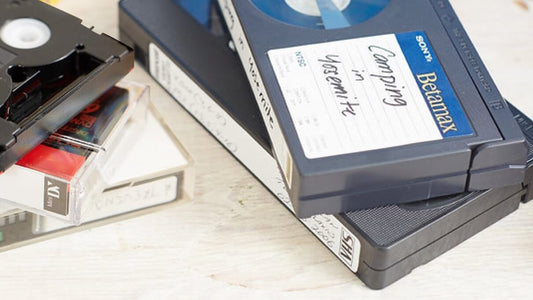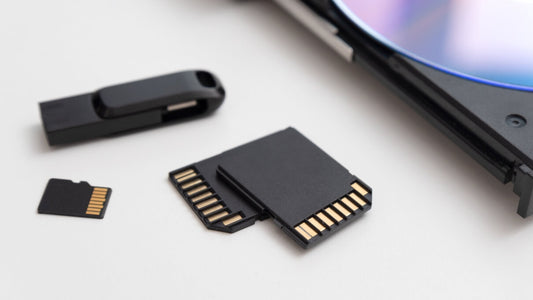DVDs were the most popular method for home videos for over a decade and still remain fairly popular despite being largely replaced by digital downloads and streaming platforms. Not only that, but some rare DVDs and special editions remain popular among collectors and enthusiasts, but do you know when and how the DVD format began?
Capture can turn your VHS tapes, photos, and analog film into digital DVD copies, but we also think it’s important to understand the history of different formats and the way they shape and store our most precious memories. That’s why we put together this article to thoroughly answer the question, “When did DVDs come out?”
Keep reading to learn about the historical timeline of DVDs including the technological background, release date, features, and cultural impact.
Jump to:
- The Evolution of Home Entertainment
- The Birth of DVDs
- DVD Release Date
- Impact and Adoption of DVDs
- DVD Features and Advancements
- Cultural and Historical Significance of DVDs
The Evolution of Home Entertainment

Before DVDs, the history of the VHS format and other videotape formats like Sony Betamax shaped home entertainment. These analog formats would store home movies, Hollywood films, and other data onto magnetic tape that could be read by a vintage VCR system.
VHS was first introduced by JVC in Japan in 1976 and revolutionized home entertainment. Through the late 70s, 80s, and early 90s, this was the preferred way to watch home movies, buy Hollywood films, and rent your favorite feature motion pictures.
However, companies were already working on digital storage options and discs. For example, Laserdisc was an optical disc storage format developed by MCA DiscoVision in 1978. While not fully digital, it offered higher-quality video and audio than VHS and Betamax tapes, but it still lost the format war eventually.
These technologies that combined digital and analog storage like Hi8 tape players, Laserdisc, and others led directly to the evolution of DVD technology.
The Birth of DVDs

The technologies and concepts developed for the Laserdisc by MCA and Philips laid the foundation for the development of Compact Disc (CD), DVD, and Blu-Ray. The goal was to not only improve quality, but to offer the ability to store more data.
The first of these formats to be introduced was audio CDs, which led to other CD-ROM disc formats that contained video games, photos, and even videos with Super Density Discs like the Multimedia Compact Disc (MMCD), but there was still an issue with storing complete movies on disc formats.
That’s because the storage capacity of a CD vs DVD is 700 MB compared with 4.7 to 17 gigabytes. Therefore, these high-capacity CD formats still weren’t enough to hold your favorite Disney movies or 80s horror flicks. Because of that, companies continued working on compact disc technology until the DVD debut.
Then, early pioneers Toshiba and Time Warner had been working on DVD technology using the name “digital video disc,” but this was changed to “digital versatile disc” after computer companies like Apple and Microsoft complained that it left out other applications like the ability to organize old photos, play video games, and more.
However, it wasn’t long before these innovations led directly to the introduction of DVDs and DVD players in the home entertainment market.
DVD Release Date

In September 1996, the first Digital Video Disc (DVD) technology was finalized and released in Japan on November 1, 1996. The official DVD release date in the United States was March 24, 1997, and the original DVD format had limited specifications because it only offered a single layer to store 1.46 gigabytes.
The first movie to be commercially released on DVD format in the United States was “Twister.” However, titles like “Blade Runner” and “The Fugitive” were released with the first DVD players in Japan before DVDs hit the domestic U.S. market.
At the early origin of DVDs, the format was still more expensive than VHS. It was clear that people preferred the discs because VHS tapes don’t last forever and DVDs offer better picture resolution, higher audio quality, larger capacity, and more compact size. Still, the higher cost would slightly delay the impact the DVD introduction to the market would have on home entertainment.
Impact and Adoption of DVDs

After the DVD invention date, DVD players began to be sold at retailers almost immediately and the format became a huge hit ending up in Blockbuster stores, Walmart, Amazon, and everywhere else.
However, due to the higher price and need for people to buy their first DVD players, it wasn’t until 2003 that DVD rentals surpassed VHS rentals for the first time. By 2007 about 80% of Americans owned a DVD player and DVD sales had completely replaced VHS for consumer electronics. Pretty soon, families began using services like Costco to transfer VHS to DVD to adapt to the DVD emergence.
After movie distributors adopted the DVD format, two of the four leading video game console companies, Sega and 3DO Company, said they would soon design gaming consoles with DVDs as the source medium. This led to several new consoles that used the format including the Sony PlayStation 2 and Microsoft Xbox.
DVD Features and Advancements

The original features of a DVD include 4.7 GB storage capacity (over 2 hours of video), 720 x 480-pixel resolution, ability to skip to chapters without needing to rewind or fast-forward, and the ability to store multiple file and media types.
Throughout this period, DVD technology continued to improve. The dual-layer DVD was introduced that could store more data and HD-DVD and Blu-Ray discs built upon the original video resolution for a clearer picture and more vivid colors. Additionally, double-sided DVD discs were also introduced. These options doubled the capacity of a normal one-sided DVD.
DVD releases began to incorporate interactive menus to select bonus features, blooper reels, extended-release feature films, and even games and quizzes. This was something that never would have been possible with analog formats without using a VHS to digital converter.
As DVDs and DVD players became cheaper and cheaper, many families stocked up on feature films. Then, the release of DVD-R and DVD-RW formats made it possible to transfer VHS movies to blank DVDs as long as you had the right equipment.
Home entertainment was changed forever after the DVD launch year, but it didn’t last long because technology continued to progress.
Cultural and Historical Significance of DVDs

The invention of the DVD is only the beginning of the cultural impact that DVDs had. DVDs influenced our home movie watching experience and made our old VHS tapes obsolete. In addition, they contributed to the major shift toward digital.
Computers even added DVD drives and we left analog media in the past. Everything went digital and DVD was a big part of that. At the same time we were shifting to Email, moving to the internet, and leaving vintage cassette players behind for CDs, we changed from VHS to DVD. Because of this, much of the nostalgia from the period is tied to the DVD format.
People started to collect DVDs and build collections of their favorite films. In some cases, people sought out rare copies, special editions, and complete collections of iconic series. The highest selling DVD of all time, “Finding Nemo,” sold over 38 million copies, but other DVD copies are cherished by collectors for being rare or valuable.
Unfortunately, the dominance of streaming and digital downloads eventually spelled the end of the DVD format. Streaming services like Netflix, which started by shipping DVD discs, offered immediate playback and instant gratification. DVD was no match when you could access an entire movie library from your living room.
Even though DVDs have been left behind like VHS tapes and Super 8 film before that, the years of DVD dominance left an impact on popular culture and our memories.
Conclusion
Now that you know the answer to “When did DVDs come out?” as well as the entire history of DVD, you can look back on those years, rewatch your favorite DVD movies, and reminisce about the format that shaped our lives for nearly 2 decades. From the introduction in 1996 and 1997 to dual-layer DVDs, major releases, and storage of photos, home movies, and more, most families still have DVDs lying around.
If you are one of those families with DVDs or even old VHS tapes lying around, Capture can help you upgrade to cloud storage and preserve your home movies and family photos forever. Click here to learn about our home movie digitization services!









